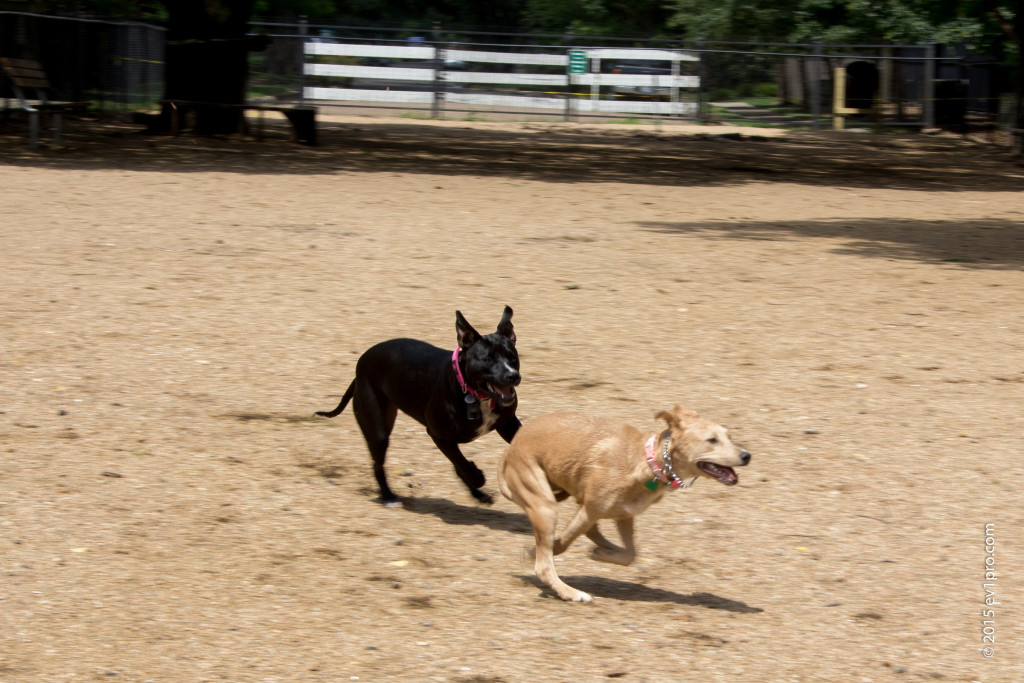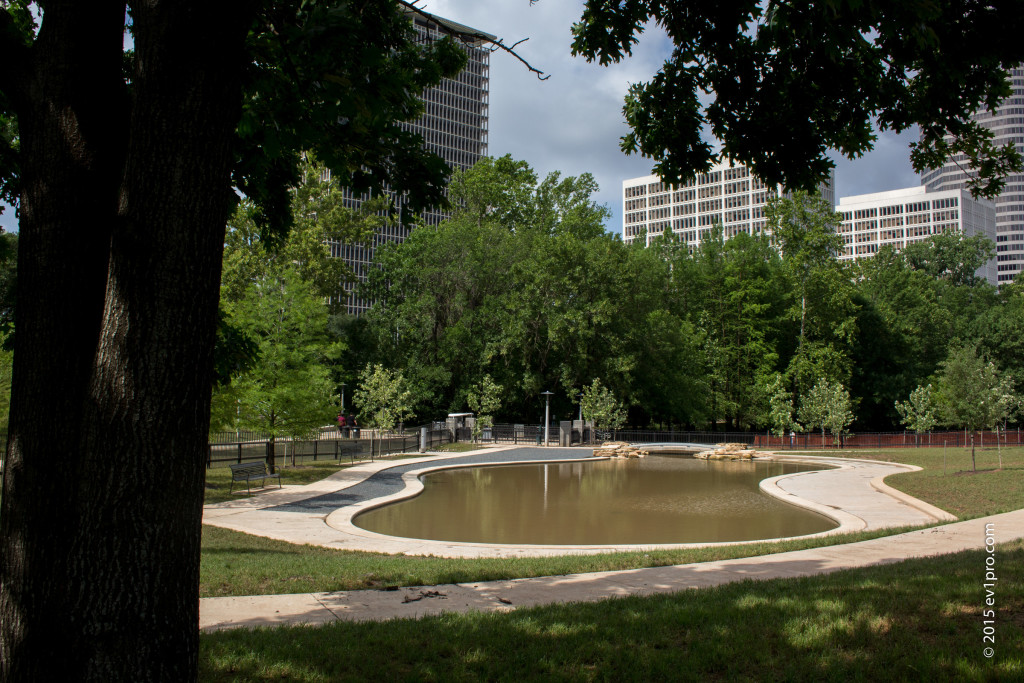Dogtown: In Montrose, Good Dogs Can Make For Good Neighbors

One Stab climbs onto his owner’s knees, folds four bony legs, and cuddles like the lap dog he is not.
“He used to live alone on my nephew’s ranch,” says Tim Mapes, an oil and gas man with a snow-white buzz cut. The two have just arrived for their daily visit to Ervan Chew Park’s dog run. “I saw him when I was hunting and said, ‘He doesn’t have any water.’ My nephew said, ‘These dogs live off the land,’ and I said, ‘I don’t know how to make this work, One Stab, but I’m bringing you home.'”
That was in 2014, and home was Mapes’ Montrose townhouse. Within weeks, One Stab adapted to city life with a flourish. And because Montrose has perhaps the most dog-friendly culture in Houston, Mapes found himself adapting too. One Stab, he says, has changed his relationships with his neighbors, with the urban landscape, even with his own health.
Such life changes happen a lot here, Montrose dog owners say. In other parts of Houston dogs are pets, companions, family members. But in Montrose – at once densely populated, walkable, and canine-crazy – dogs are also neighbors.
For Mapes, who has lived on Mandell Place since the 1990s, life with One Stab means wandering much farther afield. Now, when they’re on constitutionals, people stop Mapes to recount how they found their own dogs. Most of the tales involve rescue and redemption. “Everybody kind of has a story,” Mapes says. “The stories kind of tear my guts out. I find myself saying, ‘Well, thanks for doing that.’”

Dogs in Montrose live unusually public lives. The morning sidewalk rush at West Gray and Montrose mingles uniformed schoolchildren with min pins and schnauzers going to one of two daycares on the same block. Walk your own dog down a residential street at almost any time of day, and it’s rare not to pass another dog and human also taking the air. Longtime canine friends joyfully pause to commune in the street; some have neighborhood rounds and regularly duck into dog pals’ front yards or houses during their walks for play dates. At Canopy, which offers one of Montrose’s array of dog-friendly patios, a quiet Saturday night dinner is livened by an invisible dog under a chair yipping at a new arrival. The dinner guest just laughs.
Americans overall are dog people. Forty-three percent of U.S. residents have children, but 67 percent of American households have a pet. About 83.3 million of these are dogs. And while Texas may rank just ninth nationally in dog ownership, Montrose has one of Houston’s highest concentration of canines.
Maybe dog lovers are temperamentally drawn to Montrose. Perhaps the easy walking and dog-friendly vibe prompt dog ownership. Contrary to what one might think, though, single adults and young childless couples – the populations that help make Montrose distinctive – adopt fewer dogs than 1950s-type nuclear families. “The largest demographic to own dogs are families with children in the household,” says Bonnie Beaver, a Texas A&M professor. In addition, older Americans whose children have left home are also adopting dogs in growing numbers.
What has changed nationally, and markedly in Montrose, is how dog owners treat their pets. In 2014, Americans spent $58 billion – an all-time high – on their pets. According to the Associated Press, the “humanization” of pets started about 20 years ago, and manufacturers responded fast with products welcoming animals into the house rather than the yard. Pet foods, in particular, tend to echo human food trends, so pet companies now sell far more specialized dog cuisine: gluten free, breed specific, all-natural, and even foraged.

Dog pampering has clearly increased over the past decade in Montrose says Kendra Payne, the easygoing manager at Molly’s Mutt House at Montrose and Hawthorne. The Mutt House, which opened in Montrose last September, is one of a number of dog-centric businesses spread across the neighborhood, including Dogs R Dogs, Demi’s Dog House, The Best Little Doghouse in Texas, Dogtopia, and Jackson’s Place Dog Daycare & Bakery, among others.
Molly’s Mutt House was actually founded in Montrose a decade ago, then picked up and moved to the Heights before expanding to the Galleria. In 2014 the Mutt House returned to Montrose with its third store.
The shop offers a variety of services, including doggie daycare, boarding, and a variety of products and food, including a veritable Whole Foods of sustainable delicacies: chemical free, American-grown animal parts such as “moo tubes” (bits of cow esophagus), dried pig snouts resembling pretzels covered in white chocolate, and beef knuckles, size medium and large.
In the back of the Mutt House is a row of cubicles and two pens that offer the main services, boarding and daycare. On the walls hang classic images of Marilyn Monroe and World War II pinup girls.
“Montrose has really become a lot more open to dogs,” Payne says. “People accept dogs more, let them into stores now. It’s a lot more profitable now to board dogs, too. It’s not taboo to take your child to daycare, and people are doing it more with their dogs. Maybe it’s because young professionals aren’t having children, so they’re treating their dogs like their children.”
In contrast to Galleria residents, who dash in and out to drop off their dogs, Montrose dog owners are in less of a rush, Payne adds. Many stroll over from the Starbucks or Einstein Bros. Bagels next door and impulsively scoop up $29 sliced elk antlers.

But Montrose was setting dog culture trends before elk antlers went mainstream. Funded by local residents and opened in 2004, Ervan Chew Park was the city’s first neighborhood park with space for dogs to legally run off-leash. In January, the off-leash movement reached another peak in Montrose, with the opening of the spectacular Johnny Steele Dog Park on Allen Parkway, between Montrose Boulevard and Waugh Drive.
With fountains, ponds, boulders, and pavilions, the park was clearly designed with the interests of humans, not just dogs, in mind. More and more, though, that distinction is fading.
“Definitely, I chose to live in this area because it’s walkable,” says Eliza Ching, a pianist who works at Rice. Ching’s Australian Shepherd, Scout, bounds joyously alongside the pond at Johnny Steele Dog Park, his hair matted with rainwater and mud. Much as she liked Montrose before, Ching now savors the neighborhood even more because of Scout.
“I know my neighbors,” she says, “and not just my immediate neighbors, but the ones across the street and the ones down the street. With Scout I’m in front of my townhouse, hanging out all the time. People talk to you. You seem more approachable.”
At the same time, the neighborhood’s passion for its dogs is frazzling some relations between its humans. On a number of blocks, households that for years included only one dog now have two. This increase in canine companions is typically a reflection of an owner’s sensitivity to the needs of dogs as pack animals. But in closely packed Montrose, helping dogs be better adjusted can sometimes result in ear-splitting noise.
“It’s neighborhood density,” says Heather Lambert, a software specialist in East Montrose. “That, and everyone’s working, so they feel sorry for their dogs. There used to be a tent factory near me, and they were the ideal neighbors because their building took up the entire city block. About 15 years ago, they sold the property and 40 or 50 townhomes came up overnight. All the people who live there have dogs.”
Lambert, who doesn’t own a dog, is virtually surrounded by families with pairs of them. “What happened like clockwork,” she says, “is pretty much every night my neighbor’s two dogs would come outside. The people across the street had their dogs out all the time so they’d all start barking at each other. Then the dogs down the street would start. It was this cacophony.”
In recent months, one of the families moved away, and the block has gotten quieter, Lambert says. “This is consistent with my major rant about dogs,” she says. “If you are going to be a dog owner, you need to be a responsible dog owner. You need to socialize and walk it so doesn’t have these behavior problems. It’s infuriating to me the way some people treat someone as social and intelligent as a dog.”

Over at Ervan Chew Park, the once-lonesome One Stab has no such problems. Mapes, who is single, has reconfigured his whole schedule to make sure his dog gets enough love.
A walker comes to take One Stab out two times a day. Mapes, who works in an office building downtown, then returns at lunch to escort him to the park.
But even that’s not enough – for Mapes.
“I want to take him to work with me,” Mapes says. “I’m saying that he’s a service dog. The only obstacle is the guard and building manager. I called the Department of Justice, and they said a service dog just has to be trained to provide a service. So I’m saying that One Stab is an olfactory dog. If they ask who trained him, I’m saying, ‘He’s self-taught.'”
Actually, says Mapes, One Stab has provided an authentic health service. “I’ve probably lost ten pounds. I just had a physical and my blood pressure has dropped too,” he says. “It’s because I walk the neighborhood so much, three or four miles a day.”
The truth is that Mapes just wants to share as much of his day with One Stab as he can. But if, at the office, it is just the two of them, in Montrose that friendship includes more than just one human and one animal. In Montrose, owning a dog means a relationship with the neighborhood, with other people, and with other people’s dogs. It means belonging to a pack.
